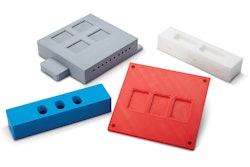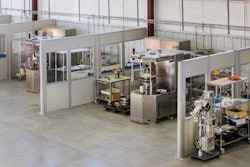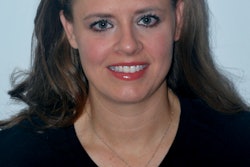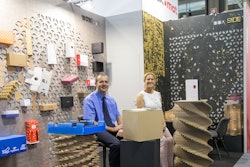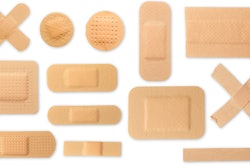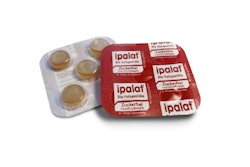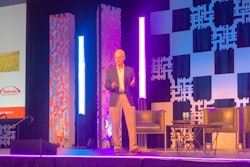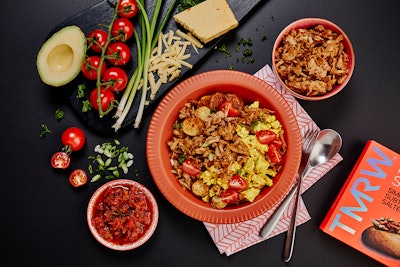
Though it might appear that the plant-based craze has caught hold of just about everyone lately, the fact is that a very small percentage of people live a fully vegan or even vegetarian way of life. The overwhelming majority of plant-curious eaters fall more within the flexitarian realm—understanding the benefits that a plant-based diet could bring to their health or to the environment, but still enjoying meat.
 TMRW is a plant-based innovation company working to reimagine how plant protein can feed people.Photo courtesy of TMRW Foods
TMRW is a plant-based innovation company working to reimagine how plant protein can feed people.Photo courtesy of TMRW Foods
TMRW aims to “create what we like to call a satisfying protein addition that’s suitable to any person’s diet by extracting the essence of what it is that people enjoy about animal protein,” Blignaut says. “We’re trying to make sure that we tick all of those boxes, especially when it comes to the kind of organoleptic properties of what it is that people enjoy about meat, but, at the same time, create a happily plant-forward protein experience that meets and exceeds the expectations of people who are used to eating meat—in terms of things like texture, aroma, cooking experience, nutritional values, etc.”
 | Carnivores, Herbivores, Omnivores... Meet Me Where You Are |
The idea, he adds, is that somebody still eating meat could have a TMRW product—whether a burger or sausage or breakfast patties—and feel like it’s a cool product but not the exact same thing.
Data-driven growth
From its launch in 2018, TMRW Foods began working on ticking all those boxes, but it quickly got to a point where it needed to tick some other boxes as well. From his previous experience at other companies, Blignaut had worked with a range of enterprise resource planning (ERP) and other management software systems and understood their importance. He also understood how difficult it would be to implement an ERP system if he waited too long and let employees settle into other habits. It was important to Blignaut, even with a small company like TMRW, to implement the system early to foster the right culture.
As a business, the plant-based food maker had started very small—with a competition at the office to create a burger—and then picked up steam quickly, testing recipes with chefs, food scientists, and more. “In 2019, we had our first prototype of the TMRW Burger,” Blignaut says. “We opened our 5,000-sq-ft production facility in Port Coquitlam in April [2020], and now we have national distribution through UNFI Horizon, and we sell it to chains like Whole Foods and Nesters and so forth.”
As TMRW sought out the right ERP system, one of the most important requirements for operation was an easy-to-use traceability system, Blignaut says. “Inventory management was another box that we wanted to tick. Also productivity tracking, dynamic costing abilities, being able to ensure consistency of execution with our team throughout different facets of the business—not just in production, but QA, QC, purchasing, anything along those lines,” he explains. “Inspections and data logging was an important part of it for us as well, because we understand that it can become quite tedious and cumbersome to have to do too much manually on paper, and it’s also a waste from a sustainability element.” Other factors to consider were facility and equipment maintenance, and in-production QA and QC checks, he adds.
 | Get a Peek at This Year's Global 250 and the Trends Driving Sales |
Blignaut focused on finding a “fluff-free” ERP system that stuck to the most important aspects of production, safety, and quality. It was also important that the system be easy to navigate, making training easy for all employees. He reached out to industry association BC Food & Beverage to get recommendations on the kind of high-performance system he had in mind, and they recommended Icicle Technologies, which specializes in food and cannabis industries. After reviewing several options, Blignaut became sold on the suitability of Icicle’s system.
A big positive, Blignaut says, is that Steve Burton, Icicle’s CEO and founder, did the demo of the system himself. “He obviously knows the system inside out,” Blignaut says. “He could very quickly answer any kind of questions we may have had or put at ease any concerns that may have come up throughout the process, and also speak to future developments.”
The traceability functionality has been one of the most useful aspects of the ERP system, according to Blignaut. “We wanted to make sure that we had a really robust tracing system, not just so that we can meet or appease regulators, but because we really wanted to feel like if there was anything that happened, that we could very confidently go and trace it, and be able to report that information to whoever it might’ve affected,” he says. “I think that the way that we’ve managed to incorporate it, and the way that it’s followed all the way through our system, is really helpful.”
Not only did the Icicle ERP have what Blignaut knew he wanted in the system, but it came with some surprises as well, including the ability to handle food safety and hazard analysis critical control point (HACCP) aspects. “As we started digging into the different offerings, the HACCP component of it found its way into the conversation,” he says. “We at the time were building out a HACCP plan, and when we found out that we could actually build out the plan directly into our system vs. having two separate pieces running concurrently, then that became an attribute that we saw as being very valuable as well.”
Implementing the ERP system
Because of facility delays in both permitting and construction, TMRW had more time that initially expected to iron out details on the ERP system. “One thing that made it more challenging for us was that we weren’t implementing in an existing facility that we had been working in for a while. It was brand new, and we had to mentally visualize a lot of what we thought would happen in the space, from previous experience and so forth, then make some assumptions,” Blignaut explains, adding that an emphasis on the quality and structure of the information from the beginning helped that situation. “Once you have a really good structure, it’s much easier to slot all the following bits in. I found that before with certain kinds of management systems—they’re incredibly robust and very powerful, but if you’ve got chaotic information structures, it doesn’t really help.”
TMRW also spent a lot of time on the HACCP plan and understanding what it needed, and also what Icicle could automate. “There were some aspects which we had to do manually and some aspects Icicle automated quite well,” Blignaut says. “But more than anything, the fact that it could piece it all together and save it in one place and allow us to make iterative adjustments to it was really helpful, and so the plan went through multiple updates before we even opened the facility.”
 Using tablet devices made it relatively easy for workers to get used to using the Icicle ERP system.Photo courtesy of Icicle Technologies
Using tablet devices made it relatively easy for workers to get used to using the Icicle ERP system.Photo courtesy of Icicle Technologies
TMRW made sure inputs were added and traced correctly, highlighting issues along the way to keep raising the bar for its team standards. “We have a really high standard here, and we wanted to ensure that that standard was set and that it was nurtured and fostered, whilst the team was still small,” Blignaut says.
Remote glimpses into production
Although Blignaut likes to be on the production floor to see what’s going on firsthand, he appreciates that his workers might not always want him under foot. He’s able to use the ERP system to do quick remote checks as well.
“It allows me to pretty quickly see if things are running smoothly, if we’re meeting expectations around productivity, costing; if the information is accurate and clean; if all of the safety checks are being done, QA checks,” Blignaut says. “It’s just a good way for me to know that the team is following our process, because the longer-term goal is that you could remove anybody from our team, including myself, and our system would be able to keep things moving at a fairly high level of execution. And this foundation which Is Icicle is an absolutely critical component of that.”
As TMRW evolves, Blignaut expects to use the ERP system less for ensuring that people are physically doing what they need to do on the floor and more for capturing the information needed to optimize production. “I understand the value of having a system that helps a group of people working together and work well without constant micromanagement,” he says.
Looking forward
Blignaut has ideas about how he’d like the software to move forward, including incorporating dynamic costing for core ingredients, and he appreciates the feedback loop he has with Icicle Technologies as the supplier considers what it will include in future iterations.
“One that I am probably the most excited about, especially once we can get the conversion built into it, is the dynamic costing features,” Blignaut says.
He does a lot of financial modeling based on assumptions, aiming to break things down as much as possible in order to understand what things cost. “In general, that’ll give you a high level understanding of whether or not you’re on your way to profitability,” he says. “However, having the dynamic costing options, where you can incorporate labor, food cost based on actual purchase orders—ideally any kinds of exchange would be incorporated in eventually.”
Blignaut is looking forward to having all the data he needs to drive the process. “That is incredibly useful because it’s wonderful to be able to vet your assumptions based on what’s actually happening on the floor, and based on your output, and everything that went into that, including waste,” he says.
